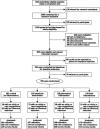Effects of computerized guidelines for managing heart disease in primary care
- PMID: 14687254
- PMCID: PMC1494965
- DOI: 10.1111/j.1525-1497.2003.30635.x
Effects of computerized guidelines for managing heart disease in primary care
Abstract
Background: Electronic information systems have been proposed as one means to reduce medical errors of commission (doing the wrong thing) and omission (not providing indicated care).
Objective: To assess the effects of computer-based cardiac care suggestions.
Design: A randomized, controlled trial targeting primary care physicians and pharmacists.
Subjects: A total of 706 outpatients with heart failure and/or ischemic heart disease.
Interventions: Evidence-based cardiac care suggestions, approved by a panel of local cardiologists and general internists, were displayed to physicians and pharmacists as they cared for enrolled patients.
Measurements: Adherence with the care suggestions, generic and condition-specific quality of life, acute exacerbations of their cardiac disease, medication compliance, health care costs, satisfaction with care, and physicians' attitudes toward guidelines.
Results: Subjects were followed for 1 year during which they made 3,419 primary care visits and were eligible for 2,609 separate cardiac care suggestions. The intervention had no effect on physicians' adherence to the care suggestions (23% for intervention patients vs 22% for controls). There were no intervention-control differences in quality of life, medication compliance, health care utilization, costs, or satisfaction with care. Physicians viewed guidelines as providing helpful information but constraining their practice and not helpful in making decisions for individual patients.
Conclusions: Care suggestions generated by a sophisticated electronic medical record system failed to improve adherence to accepted practice guidelines or outcomes for patients with heart disease. Future studies must weigh the benefits and costs of different (and perhaps more Draconian) methods of affecting clinician behavior.
Figures
Comment in
-
Understanding and modifying physician behavior for prevention and management of cardiovascular disease.J Gen Intern Med. 2003 Dec;18(12):1060-1. doi: 10.1111/j.1525-1497.2003.31002.x. J Gen Intern Med. 2003. PMID: 14687267 Free PMC article. No abstract available.
References
-
- Institute of Medicine. Crossing the Quality Chasm: A New System for the 21st Century. Washington, DC: National Academy Press; 2001.
-
- Brennan TA, Leape LL, Laird NM, et al. Incidence of adverse events and negligence in hospitalized patients. Results of the Harvard Medical Practice Study I. N Engl J Med. 1991;324:370–6. - PubMed
-
- Brand DA, Newcomer LN, Freiburger A, Tian H. Cardiologists' practices compared with practice guidelines: use of beta-blockade after acute myocardial infarction. J Am Coll Cardiol. 1995;26:1432–6. - PubMed
-
- Peterson LA, Norman ST, Leape LL, McNeil BJ. Comparison of use of medications after acute myocardial infarction in the Veterans Health Administration and Medicare. Circulation. 2001;104:2898–904. - PubMed
-
- Kennedy HL. Current utilization trends of beta-blockers in cardiovascular disease. Am J Med. 2001;110(suppl 5A):2S–6S. - PubMed
Publication types
MeSH terms
Grants and funding
LinkOut - more resources
Full Text Sources
Medical


